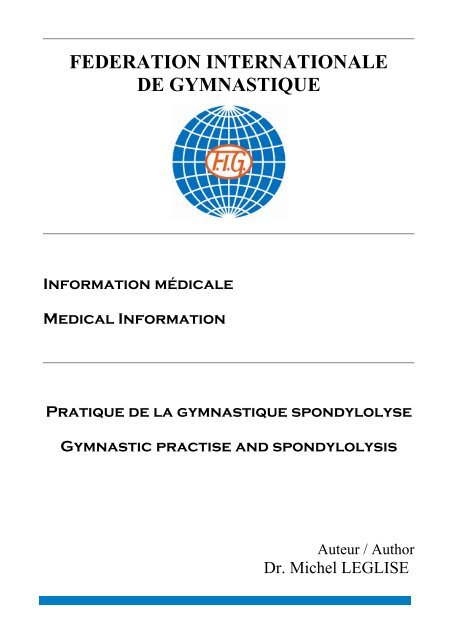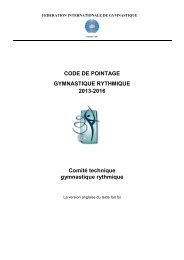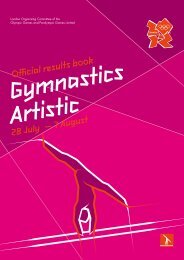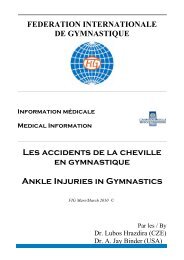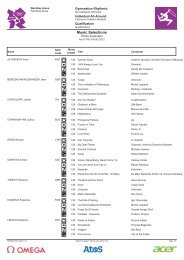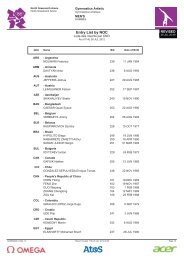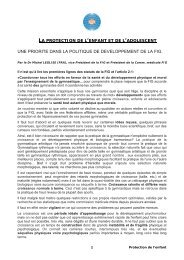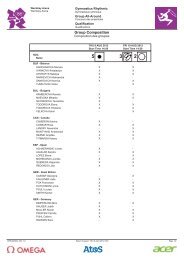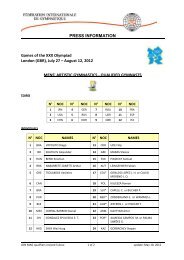FEDERATION INTERNATIONALE DE GYMNASTIQUE
FEDERATION INTERNATIONALE DE GYMNASTIQUE
FEDERATION INTERNATIONALE DE GYMNASTIQUE
Create successful ePaper yourself
Turn your PDF publications into a flip-book with our unique Google optimized e-Paper software.
<strong>FE<strong>DE</strong>RATION</strong> <strong>INTERNATIONALE</strong><br />
<strong>DE</strong> <strong>GYMNASTIQUE</strong><br />
Information médicale<br />
Medical Information<br />
Pratique de la gymnastique spondylolyse<br />
Gymnastic practise and spondylolysis<br />
Auteur / Author<br />
Dr. Michel LEGLISE
GYMNASTIC PRACTISE<br />
and<br />
SPONDYLOLYSIS - SPONDYLOLISTHESIS<br />
Dr Michel LEGLISE<br />
President of the medical commission of the FIG<br />
Spondylolysis is a lesion caused by an acute or stress fracture generally affecting the<br />
vertebral isthmus at L5 S1 or, less frequently, at L4 L5. The condition is exacerbated when<br />
the athlete falls or slips during activity with the back in a hyperextended hyperlordotic<br />
position, which aligns the pedicles impacting the isthmus.<br />
A genetic or ethnic predisposition may also play a role, and in some cases the condition is<br />
due to a difficult childbirth.<br />
The critical period of onset occurs between the age of five and seven years.<br />
Isthmus lysis may present unilaterally or bilaterally.<br />
Spondylolisthesis is the anterior displacement of the vertebral column in relation to the<br />
vertebrae or sacrum below, made possible by spondylolysis or by the elongation of the<br />
interarticular segment of the posterior vertebral arch, otherwise known as the isthmus.<br />
About 1/3 of all spondylolyses progress to spondylolisthesis, the majority of which remain a<br />
Grade 1 lesion ( approx. 85% of cases). Studies show that the incidence of isthmian lyses is<br />
4-8% in the general population, but as high as 16-22% in high-level gymnasts which is<br />
higher than in most other sports).<br />
I.A. KAPANDJI Physiologie articulaire -Librairie Maloine-<br />
-1 -<br />
July 2008
There are three grades of spondylolisthesis which correspond to varying degrees of<br />
dysplasia.<br />
These dysplasias are located:<br />
• at the 5th lumbar vertebra: atrophy of the articular apophyses, spina bifida, a thinned<br />
and elongated isthmus. The vertebral body may assume a trapezoid shape, with the<br />
anterior side shifting higher than the posterior.<br />
• at the sacrum, dysplasia may develop on the sacral plateau, either domed or S<br />
shaped, and depending on the positioning of the sacrum, it may be vertically or<br />
horizontally oriented. It may have a hook or rectilinear shape.<br />
• the intervertebral disc becomes flattened, losing its shock absorbing and stabilising<br />
capacities, which causes slipping and displacement of the disc.<br />
Dysplasia Classification (Roy-Camille)<br />
GRA<strong>DE</strong> I Minimal dysplasia at the L5 vertebral body, slightly trapezoidal at the<br />
posterior arch with spina bifida occulta.<br />
GRA<strong>DE</strong> II More pronounced dysplasia. The L5 body is trapezoidal, the sacral<br />
dome is S shaped, the sacrum appears hooked. Dysplasia of the L5<br />
posterior arch is more advanced than in grade I.<br />
GRA<strong>DE</strong> III Major dysplasia causing a deformed vertebral body, a veritable<br />
trapeze, the isthmus is elongated and the vertebral plateau is domed<br />
(risk of slipping is extreme).<br />
Four stages of development categorise spondylolisthesis based on the severity of<br />
the slip :<br />
Stage I Minimum slipping of less than 1/3 of the vertebral plateau, no<br />
dysplasia.<br />
Stage II Slipping of 1/3 to 2/3 of the trapezoidal dysplasia plateau, S shaped<br />
sacral dome dysplasia of the posterior arch.<br />
Stage III Slipping of more than 2/3 of the vertebral body plateau in trapeze;<br />
domed plateau.<br />
Stage IV Spondyloptosis<br />
-2 -<br />
July 2008
SYMPTOMS<br />
Simple isthmus lysis is often asymptomatic, even when associated with a grade I listhesis.<br />
Two relatively typical clinical cases:<br />
• Acute spondylolysis in children; the child presents with a violent lumbago usually<br />
after a lumbar hyperextension. Pain may radiate to the posterior thigh; it is<br />
debilitating and worsens when the patient participates in sport. Clinical findings are<br />
usually inconclusive, with lumbar stiffness and paravertebral muscle spasm in the<br />
abscense of neurological findings.<br />
• Spondylolisthesis in adolescent athletes<br />
The onset of low-intensity lumbar pain that increases with training; acute episodes of<br />
intense pain may occur over a period of a few weeks.<br />
Progression is generally clinical ( I don’t understand this), aggravated by physiological<br />
fatigue and by a sitting or standing position.<br />
DIAGNOSIS<br />
Diagnosis is based essentially on medical imaging examinations.<br />
Systematic medical screening in asymptomatic top level young athletes has many<br />
advantages, however excessive irradiation of the pelvis should be avoided; certain countries<br />
are strict on this issue, as is the medical academy (what is the medical academy?).<br />
Common sense and wise decision making are of the utmost importance here.<br />
Having stated this, lumbago in young athletes requires X-rays in frontal-profile-3/4<br />
positions.<br />
In cases of unilateral isthmian lysis, a bone scintigraphy may be performed to pinpoint<br />
localised hyperfixation and to determine whether the lysis is recent, allowing a physician to<br />
accurately prescribe a possible rehabilitative brace.<br />
A bone scan may reveal lyses which have gone undetected by X-rays; it may uncover<br />
posterior articular lesions and confirm the existence of minimal spondylolisthesis with<br />
images revealing pseudo-protrusion of the disc.<br />
An MRI is useful in determining the exact location of lesions in gymnasts with<br />
spondylolisthesis, particularly in cases of sciatica, disc lesions, foraminal stenosis or ductal<br />
stenosis.<br />
-3 -<br />
July 2008
TREATMENT<br />
Acute spondylolysis in children<br />
Rest is prescribed for children once an isthmic fracture has been identified. A correctly fitted<br />
cast or brace is applied.<br />
The aim of treatment is to reduce inflammation rather than actually heal the condition; most<br />
cases result in pseudarthrosis.<br />
The degree to which a patient experiences residual symptoms may determine the athlete’s<br />
sporting career.<br />
Spondylolisthises in adolescents practising high-level sport; lyses are often diagnosed<br />
retrospectively as pain episodes are considered commonplace in intensively active gymnasts.<br />
It is wise to propose a period of inactivity or to limit gymnastic exercises in both frequency<br />
and intensity. Proposed treatment for lumbosacral kyphosis includes immobilisation through<br />
the use of a brace to temporarily avoid excessive strain on the isthmus and to impede<br />
progression of the condition.<br />
If pain persists during sporting activities, a number of surgical procedures may be considered<br />
depending on the type and severity of the slip.<br />
MEDICAL SUPERVISION<br />
GYMNASTIC PRACTISE ACCESS<br />
The main issue is whether or not the athlete can conduct gymnastic activities despite the<br />
presence of a spondylolysis or listhesis. Pain tolerance translates into stability. When<br />
pain is absent in cases of lysis, there is no correlation between discomfort and the severity of<br />
the slip.<br />
When a disc is normal despite the grade of spondylolisthesis, clinical tolerance is usually<br />
rather good; as the disc degenerates, the spondylolisthesis usually becomes more advanced.<br />
-4 -<br />
July 2008
ABILITY TO PARTICIPATE IN GYMNASTICS<br />
IMPORTANT CRITERIA<br />
Pain, and in particular joint pain, is always a major sign of distress which must not be<br />
ignored. The absence of pain does not signify the absence of pathology, and the intensity<br />
of pain is not always in proportion with the severity of the lesion.<br />
In the absence of pain, it is still important to make a diagnosis. This is not an easy task. It<br />
has been recommended that a minimum of radiological examinations be carried out routinely<br />
(Is this what you mean?). When pain is present, a medical and radiological examination<br />
should be obligator.<br />
Pain remains the most important clinical indication in diagnosing a condition. It s important<br />
to evaluate the level of exertion an athlete can tolerate and to allow correct training to<br />
continue but always keeping well under the athletes pain threshold.<br />
• Gymnast Morphology<br />
Attention should be given to the gymnasts’ morphology and, particularly, the<br />
presence of hyperlordosis.<br />
• Clinical history and examination<br />
These are both very important in evaluating disc and related pathologies.<br />
• Dysplasias<br />
In cases of dysplasia, grade plays an important part in deciding to what extent an<br />
athlete may engage in physical activity. Gymnasts with Grade III dysplasia must NOT<br />
train or participate in competition, this is an absolute contraindication, whereas<br />
grades I and II are open to individual interpretation.<br />
• Isthmus lysis with or without listhesis<br />
Severity staging (I – IV) of vertebral slip is important when discussing the level of an<br />
athlete’s physical activity. Athletes with Stages III and IV should not participate in<br />
gymnastic activities. Stages I and II are open to interpretation.<br />
-5 -<br />
July 2008
TECHNICAL CONSI<strong>DE</strong>RATIONS<br />
• Giving professional advice on the acceptable intensity and frequency of gymnastic<br />
activity is of utmost importance. It provides an opportunity for subacute pain<br />
episodes to pass, and allows a gymnast to limit his training programme as well as the<br />
number of annual competitions in which he will participate. Good management will<br />
help a gymnast to select a reduced number of apparatus, which will ultimately ease<br />
stress on the lumbosacral joint.<br />
• The quality and technical mastery of gymnastic elements play a significant role in<br />
the tolerance of articular (particularly spinal) pathologies<br />
• Quality gymnastic equipment (floors, mats, etc.) is important in protecting<br />
affected joints.<br />
• Appropriate physical preparation keeps the spinal column flexible, toned and wellpositioned<br />
(cf. negative effects of hyperlordosis).<br />
• Technical regulations, notably the points scoring systems, should take into<br />
consideration the risks involved for the spine in a given exercise, and should either<br />
ban or reduce the value of these potentially dangerous exercises accordingly.<br />
This is where a coach’s involvement is essential; his or her professional, technical, ethical<br />
and organisational capacities may guide a gymnast through a period of spinal pathology.<br />
Those who establishing the rules, create the technical programmes, design the<br />
competition formats, are responsible for gymnastic equipment approval, design the age<br />
group programmes, etc., bear a heavy responsibility.<br />
MEDICAL FOLLOW-UP<br />
Just as appropriate technical support is imperative in an athlete’s career, so too are highquality<br />
and continuous medical follow-ups; they play an important role in evaluating athlete<br />
aptitude and help in gauging the athlete’s level of fitness.<br />
-6 -<br />
July 2008
NOTES<br />
The chart on page 8 helps one to evaluate different diagnostic criteria.<br />
The chart combines objective elements and subjective assessments, never forgetting that<br />
ethical considerations are the basis of any decision.<br />
A score is merely an aid in assessing aptitude. It in no way gives a definitive<br />
diagnostic or management tool.<br />
A physician’s final decision is based on his sense of professional and personal integrity. He<br />
knows that his decision may give rise to comments, remarks, and possibly strong opposition<br />
on the part of the gymnast, the gymnast’s family and sporting environment.<br />
A doctor must focus his attention on an athlete’s health. He must not be swayed from his<br />
decision, and should seek council and feedback from the national Medical Commission and<br />
other colleagues. It is his job to explain his position to the patient, to offer support in a time<br />
of psychological strain, disappointment or discouragement, and to direct the gymnast toward<br />
other physical and sporting activities, if the need be.<br />
-7 -<br />
July 2008
SPONDYLOLYSIS - SPONDYLOLISTHESIS<br />
SPORT _____________________ Discipline ________<br />
Last Name _______________ First Name____________ Date of Birth ______<br />
Dysplasias Without<br />
+<br />
Slipping Without<br />
+<br />
Disc pathology Without<br />
+<br />
Clinical Signs<br />
Pain<br />
Hyperlordosis<br />
Morphology<br />
Growth<br />
pathologies or<br />
disorders<br />
Appropriate<br />
technical<br />
follow-up<br />
Appropriate<br />
medical followup<br />
Without<br />
+<br />
Without<br />
+<br />
Without<br />
+<br />
+<br />
+<br />
Other decisive factors =<br />
GRA<strong>DE</strong> 1<br />
<br />
Stage I<br />
<br />
Moderate<br />
<br />
Pain<br />
<br />
Hyperlordosis<br />
<br />
Moderate<br />
<br />
Scoring Sum of points + and <br />
• Absolute contraindication: score < 1<br />
- 8 -<br />
GRA<strong>DE</strong> 2<br />
<br />
Stage II<br />
<br />
Significant<br />
INAPT<br />
Significant pain<br />
<br />
Pronounced<br />
hyperlordosis<br />
<br />
Significant<br />
<br />
GRA<strong>DE</strong> 3<br />
INAPT<br />
Stage III<br />
INAPT<br />
Stage IV<br />
INAPT<br />
• Temporary consent to practise. Must be renewed and is subject to regular<br />
medical evaluation and appropriate gymnastic practise: score between 1 to 3<br />
• Consent with supervision: score > 3<br />
Decision =<br />
July 2008
Document for internal use only within the FIG<br />
(Fédération Internationale de Gymnastique);<br />
may not be published or distributed for any other<br />
purposes.<br />
Bibliography and works cited:<br />
• Rachis et Sport – MASSON 1995.<br />
(c.f. PENNECOT / BENAZET – SAILLANT - CHAMBERLIN - ROLLAND - ROY-<br />
CAMILLE / M. LEGLISE)<br />
• Dr Michel LÉGLISE:<br />
- text<br />
- Chart for the evaluation of aptitude in spondylolysis and spondylolisthesis<br />
Thanks to Dr David McDonagh, FIMS<br />
- 9 -<br />
July 2008


